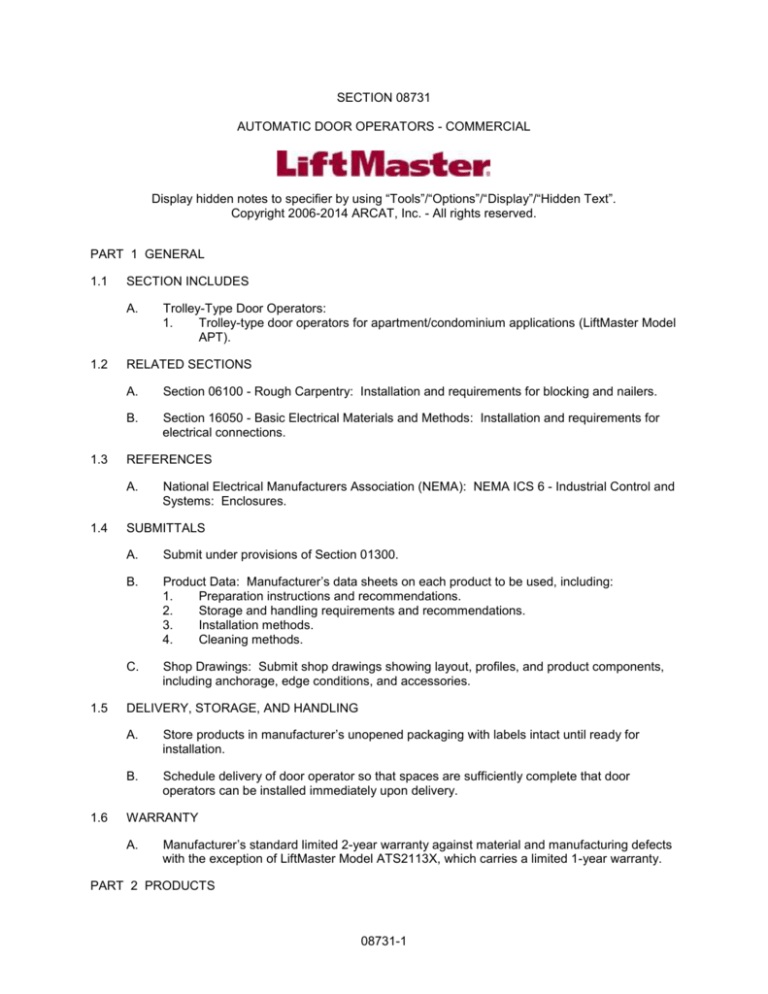
SECTION 08731
AUTOMATIC DOOR OPERATORS - COMMERCIAL
Display hidden notes to specifier by using “Tools”/“Options”/“Display”/“Hidden Text”.
Copyright 2006-2014 ARCAT, Inc. - All rights reserved.
PART 1 GENERAL
1.1
SECTION INCLUDES
A.
1.2
1.3
RELATED SECTIONS
A.
Section 06100 - Rough Carpentry: Installation and requirements for blocking and nailers.
B.
Section 16050 - Basic Electrical Materials and Methods: Installation and requirements for
electrical connections.
REFERENCES
A.
1.4
1.5
1.6
Trolley-Type Door Operators:
1.
Trolley-type door operators for apartment/condominium applications (LiftMaster Model
APT).
National Electrical Manufacturers Association (NEMA): NEMA ICS 6 - Industrial Control and
Systems: Enclosures.
SUBMITTALS
A.
Submit under provisions of Section 01300.
B.
Product Data: Manufacturer’s data sheets on each product to be used, including:
1.
Preparation instructions and recommendations.
2.
Storage and handling requirements and recommendations.
3.
Installation methods.
4.
Cleaning methods.
C.
Shop Drawings: Submit shop drawings showing layout, profiles, and product components,
including anchorage, edge conditions, and accessories.
DELIVERY, STORAGE, AND HANDLING
A.
Store products in manufacturer’s unopened packaging with labels intact until ready for
installation.
B.
Schedule delivery of door operator so that spaces are sufficiently complete that door
operators can be installed immediately upon delivery.
WARRANTY
A.
Manufacturer’s standard limited 2-year warranty against material and manufacturing defects
with the exception of LiftMaster Model ATS2113X, which carries a limited 1-year warranty.
PART 2 PRODUCTS
08731-1
2.1
2.2
MANUFACTURERS
A.
Acceptable Manufacturer: LiftMaster; 845 Larch Avenue; Elmhurst, IL 60126-1196. TollFree: 800.282.6225. Email: specs@LiftMaster.com. Web: LiftMaster.com.
B.
Substitutions: Not permitted.
C.
Requests for substitutions will be considered in accordance with provisions of Section
01600.
TROLLEY-TYPE DOOR OPERATORS
A.
Low-Profile Apartment House Operator: LiftMaster APT Low-Profile Apartment House
Operator, resilient mount motor with overload protection and emergency disconnect with
auto-reconnect trolley assembly for manual door operation.
1.
Electric Operator: Low-profile assembly, cULus listed and cULus labeled, with electric
motor and factory-prewired motor controls, 3-button open/close/stop control station,
conduit-encased wiring from control circuit to motor, and accessories required for
proper operation; operator shall drive the door at a speed of approximately 6 inches
(152 mm) per second. Operator vertical profile shall not exceed 11 inches (279 mm).
a.
Drive Reduction: Heavy-duty 5L V-belt and chain/sprocket secondary; all
reduction sprockets and pulleys shall be drilled and pinned to steel shafts
plated for resistance to corrosion; operator shall be equipped with permanently
lubricated ball bearings on output shaft, adjustable friction clutch and quickdisconnect door arm to facilitate manual operation.
b.
Brake: Standard solenoid brake to stop and hold a door at any position.
c.
Limit Switches: Fully adjustable, linear-driven limit mechanism synchronizing
operator with door; low-friction nylon limit nuts fitted on threaded steel shaft that
rotates on oil-tight self-lubricating bronze bushings; motor shall be removable
without affecting limit switch settings.
d.
Electric Motor: High-starting torque, continuous-duty, industrial-type protected
against overload by current sensing and thermal overload devices. For singlephase applications, incoming voltage field-selectable between 115V and 230V,
60 Hz by properly positioning connector.
e.
Solid-State Motor Control and Enclosure: LiftMaster Logic 5.0 motor control
shall be UL-approved microprocessor solid-state type and shall include the
capability to select one of 7 wiring types; additional features shall include a
maintenance alert diagnostic system, programmable Timer-to-Close with timer
defeat input, mid-stop programming capabilities and a maximum run timer to
provide motor overrun protection; motor control shall be housed in a NEMA 1
enclosure integral to the operator and shall conform to ANSI/NEMA ICS 6.
1.
Radio Receiver: LiftMaster Logic 5.0 on-board, 3-channel receiver with
standard external antenna; equipped to accept Security+ 2.0 Rolling
Code Technology remote controls and trinary DIP switch remote
controls, with memory up to (30) 3-button remote controls (or 90 singlebutton remote controls) plus 30 wireless keypads, or an unlimited
number of trinary DIP switch remote controls. Tri-band frequency
(310/315/390 MHz) sends multiple radio signals to bypass radio
interference.
2.
Internet Connectivity: MyQ Technology.
a) 902 to 928 MHz.
b) 50-channel FHSS (Frequency Hopping Spread Spectrum).
c) LiftMaster 828LM Internet Gateway enables monitoring and control of
door operators and lighting controls via Internet-enabled smartphone,
tablet or computer.
d) Provides two-way communication between commercial door operator
and MyQ Accessories to enable remote open, close and monitoring of
08731-2
commercial door.
3-Button Control Station: 3-button station providing open/close/stop
functionality shall be NEMA Type 1 with maintenance alert indicator to signal
intervals for routine door and operator maintenance.
g.
Door Drive: Full #48 roller chain with emergency disconnect for manual door
operation.
h.
Track: Heavy-duty, double-angle, 11-gauge galvanized steel.
i.
Trolley Assembly: 2 inches H x 2 inches W (51 mm H x 51 mm W) galvanized
steel angle rails with automatic reconnect trolley including plated steel rail
spacers with a nylon chain-guide assembly.
Primary Entrapment Protection Devices:
a.
NEMA 1 Monitored Photo Sensors: LiftMaster CPS-U Monitored Photo Eyes
fully monitored, non-contact, infrared beam photo sensor system shall reverse,
in conjunction with the LiftMaster Logic 5.0 Operator, a closing door to the full
open position when an obstruction is sensed; photo sensors shall be mounted
no higher than 6 inches (152 mm) maximum above the floor.
b.
NEMA 4 Monitored Photo Sensors: LiftMaster CPS-UN4 Monitored Photo
Eyes (industrial thru-beam) fully monitored, non-contact, photo beam reversing
photo sensor system with NEMA 4 watertight enclosure shall reverse, in
conjunction with the LiftMaster Logic 5.0 Operator, a closing door to the full
open position when an obstruction is sensed; photo sensors shall be mounted
no higher than 6 inches (152 mm) maximum above the floor.
c.
NEMA 4X Monitored Photo Sensors: LiftMaster CPS-OPEN4 Monitored Photo
Eyes (commercial thru-beam) and CPS-RPEN4 Monitored Retro-reflective
Photo Eyes, fully monitored, non-contact, photo beam reversing photo sensor
system with NEMA 4X watertight/corrosion-resistant enclosure shall reverse, in
conjunction with the LiftMaster Logic 5.0 Operator, a closing door to the full
open position when an obstruction is sensed; photo sensors shall be mounted
no higher than 6 inches (152 mm) maximum above the floor.
d.
NEMA 6 Monitored Optical Edge System (OES): Shall provide a means to
attach a 2-wire monitored sensing edge to a LiftMaster Logic 5.0 Operator for
continuous monitoring purposes; the edge, in conjunction with the LiftMaster
Logic 5.0 Operators, shall reverse a closing door to the full open position when
an obstruction is sensed; sensing edge ordered separately and can be field-cut
to required length.
e.
Monitored Sensing Edge Interface:
1.
LiftMaster CPS-MEI Monitored Sensing Edge shall provide a means to
attach a 2-wire monitored sensing edge to a LiftMaster Logic 5.0
Operator for continuous monitoring purposes; the edge, in conjunction
with the LiftMaster Logic 5.0 Operators, shall reverse a closing door to
the full open position when an obstruction is sensed; sensing edge
ordered separately and can be field-cut to required length.
2.
LiftMaster CPS-EI Monitored Sensing Edge shall provide a means to
attach a 4-wire monitored sensing edge to a LiftMaster Logic 5.0
Operator for continuous monitoring purposes; the edge, in conjunction
with the LiftMaster Logic 5.0 Operators, shall reverse a closing door to
the full open position when an obstruction is sensed; sensing edge
ordered separately.
f.
Additional monitored primary entrapment protection devices may be added with
the appropriate interface device or plug-in accessory card.
Ancillary Entrapment Protection Devices:
a.
Retro-reflective Photo Sensors: LiftMaster CPS-RN4 Retro-reflective Photo
Eyes non-monitored, non-contact, infrared beam photo sensor with polarized
reflector for use in conjunction with the LiftMaster CPS-EI Monitored Sensing
Edge and monitored 4-wire sensing edge, shall reverse a closing door to the
full open position when an obstruction is sensed; photo sensor shall be
f.
2.
3.
08731-3
4.
mounted no higher than 6 inches (152 mm) maximum and no lower than 4
inches (102 mm) minimum above the floor.
b.
NEMA 6 Monitored Optical Edge System (OES): 2-wire non-monitored electric
edge shall reverse a closing door to the full open position when an obstruction
is sensed.
c.
Non-Monitored Electric Sensing Edge: 2-wire non-monitored electric edge shall
reverse a closing door to the full open position when an obstruction is sensed.
d.
Pneumatic Sensing Edge: Pneumatic (air hose) sensing edge shall reverse a
closing door to the full open position when an obstruction is sensed.
Trolley Track: 2 inches H x 2 inches W (51 mm H x 51 W mm) galvanized steel angle
rails with automatic reconnecting trolley and shall include plated steel rail spacers with
nylon chain-guide assembly; nylon inserts will be provided on trolley mechanism and
rail spacers to reduce vibration and chain noise.
PART 3 EXECUTION
3.1
3.2
EXAMINATION AND PREPARATION
A.
Do not proceed with installation until substrates have been properly prepared and deviations
from manufacturer’s recommended tolerances are corrected.
B.
If preparation is the responsibility of another installer, notify Architect in writing of deviations
from manufacturer’s recommended installation tolerances and conditions. Prepare surfaces
using the methods recommended by the manufacturer for achieving the best result for the
substrate under the project conditions. Commencement of installation constitutes
acceptance of conditions.
INSTALLATION
A.
3.3
Install in accordance with manufacturer’s instructions and in proper relationship with
adjacent construction. Test for proper operation and adjust until satisfactory results are
obtained. Demonstrate operation to owner’s personnel.
PROTECTION
A.
Protect installed products until completion of project.
B.
Touch up, repair or replace damaged products before Substantial Completion.
END OF SECTION
08731-4











